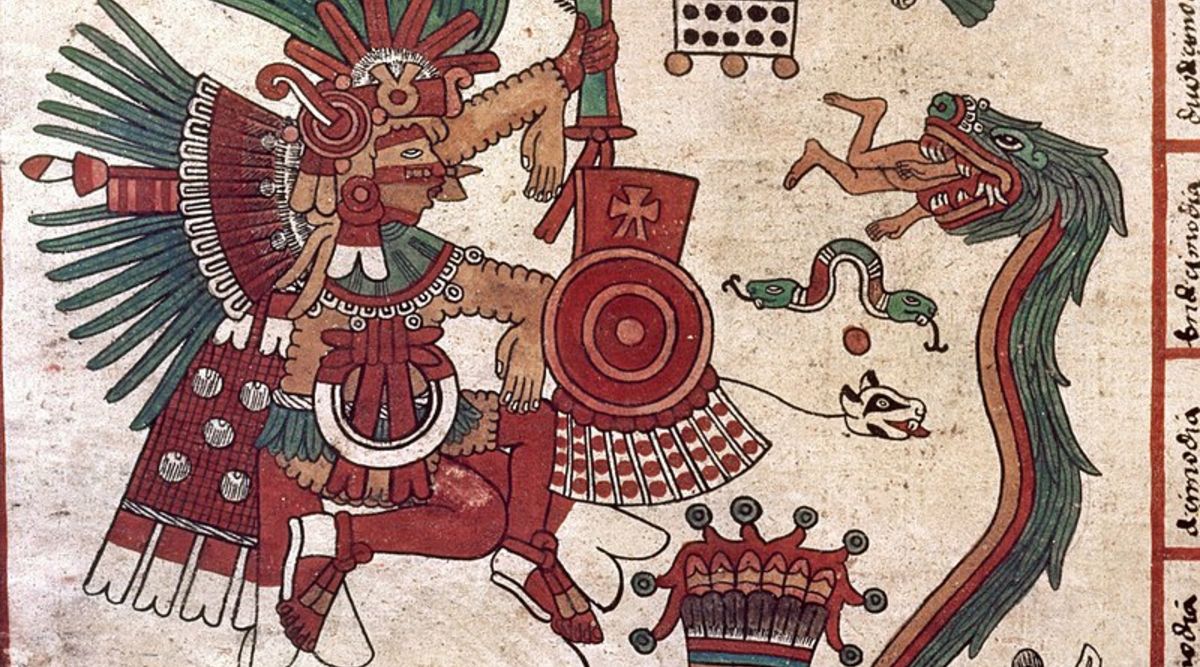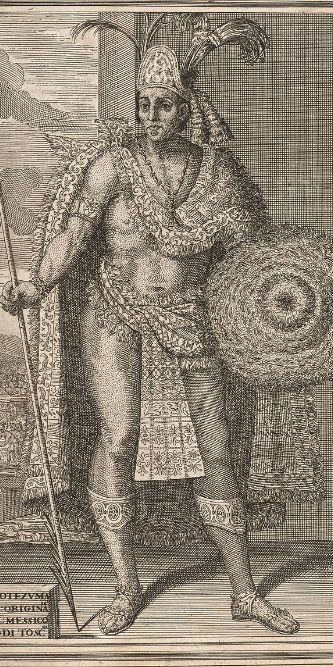Quetzalcoatl: Aztec Myths and Myths About the Aztecs

The People of the Sun and the Feathered Serpent

Quetzalcoatl, the feathered serpent god of the Aztecs, is recognized the world over in art and media. The god himself or monsters with his likeness regularly appear in fantasy books, films, and games. But, like with many indigenous beliefs from the Americas, there is a great deal of misunderstanding and misrepresentation surrounding the Aztec gods and their worshippers.
Who were the Aztecs?
"Aztec" refers to a group of Mesoamerican cultures in Central Mexico who all came from their mythic homeland of Aztlan. No group in Mexico in the 1500s referred to themselves as Aztecs —the term is usually used to describe the Mexica confederation based in Tenochtitlan, commonly known as the Aztec Empire. The confederation also comprised the Acolhua people in the city of Texcoco and the Tepanec people in the city of Tlacopan, so the three cities are more properly known as the Triple Alliance.
The Mexica are Nahua people, one of the largest ethnic groups in the Americas. Nahua people, both in the 1500s and today, commonly speak the Nahuatl language. The name Quetzalcoatl comes from the Nahuatl names for the Quetzal bird and "coatl" referring to a snake.
What did they believe?
Although there are few surviving texts, the historic peoples of Mesoamerica did have written languages dating back centuries before contact with Europe, which gives us a bit more context about their beliefs. The most comprehensive early account, though, was written shortly after the Spanish conquest of Mexico by a Dominican priest.
Some of the most important deities in the Aztec Empire were worshipped across Mexico and Guatemala, and had been around long before the construction of Tenochtitlan. A feathered serpent was worshipped thousands of years ago in Teotihuacan. The Olmecs worshipped Quetzalcoatl or an analogue. The Maya worshipped a plumed serpent named Kukulkan (or Kukulcan), to whom the Mayan temple at Chichen Itza is dedicated.
Aztec religion was much like Greek and Roman religion in that it grew and adapted over time. The Aztecs incorporated other cultures' gods after prolonged interaction, and their pantheon was quite large. They honored these gods with gifts and rituals, and each god was responsible for a particular sphere of Aztec life.
One of the Aztecs primary gods was Huitzilopochtli, a war god and the patron of the Mexica. The most important gods were the sky gods associated with the sun, the moon, and the planet Venus (Venus being known around the world as the morning star and the evening star). These are Tlaloc, the god of rain and fertility, Tezcatlipoca, the god of wind and the night sky, and Quetzalcoatl.
Quetzalcoatl has a wicked canine twin, Xolotl, who is a god of fire and a symbol of death. Xolotl was a deity that led the souls of the dead to their afterlife in Mictlan. Quetzalcoatl was also identified with the god Ehecatl, a wind god.
Aztec religion was very organized. There was the central temple in Tenochtitlan, which was closely tied to the government of the empire, and then there were other temples set up hierarchically beneath the central temple. In Aztec religious practice, priests (often called quetzalcoatlus) conveyed mortals' gifts to the gods and vice versa. This included monthly rituals and festivals organized by the temple. Some of the most important festivals did include human sacrifice.
Human sacrifice
Many mesoamerican cultures practiced human sacrifice, including the Maya and the Toltecs. In the religions of mesoamerica, sacrifice was very important. The gods were believed to sacrifice their own lives or their own blood to create the world and provide for their people, and their followers were expected to sacrifice those gifts freely in a sign of gratitude. Quetzalcoatl is believed to have given life to humans by sacrificing blood.
Sacrifice often took the form of bloodletting, where worshippers would offer their blood back to the gods. It also could involve the sacrifice of food or wealth. In the most important circumstances it involved the sacrifice of a human life. These sacrifices were chosen ahead of time by the priests in the temple; they might be citizens of the empire or its vassals, or they might be prisoners of war. Child sacrifices seem to have usually come from wealthy families, offered up by the families. Adult sacrifices seem to have come from those of any status who had fallen into serious debt, apropos of the Aztec religious focus on gratitude and indebtedness.
The extent and cruelty of the sacrifice was largely exaggerated by the Spanish, whose accounts inflate the number of sacrifices. According to the Spanish account, up to 80,000 people were sacrificed in four days to dedicate the temple of Tenochtitlan (or 15 people each minute). According to scant surviving Mexica accounts, the more accurate number is 4,000.
Popular art and literature has latched onto images of Aztec sacrifice as a source of horror or diabolical mystery. This has cemented an image of Aztec culture as cruel and barbaric. In reality, their culture was very robust in terms of art, science, and trade. They produced immense and sophisticated architecture, had complex systems of math and astronomy, and had other developed trades including medicine and shipbuilding. Even the ennobled warriors, who captured prisoners for sacrifice, were noted for their practice and performance of poetry.
What do the Spanish have to do with it?

The popular conception of Aztec religion is largely based on the accounts of Spanish conquistadors, following the destruction of the Aztec Empire and the enslavement of its people by Hernan Cortes.
The common version of the story goes that Hernan Cortes landed in Mexico and was identified with Quetzalcoatl in the form of a white-skinned or white-haired man. This led to his being brought to the capital by the king Montezuma II (also spelled Moctezuma, a Spanish rendering of Motecuhzoma) who then surrendered his empire.
The reality is more complicated. The Quetzalcoatl in the story is not the god, but a man. Ce Acatl Topiltzin Quetzalcoatl was a Toltec priest and prince from the city of Tollan. He is the subject of many myths across the Yucatan peninsula. One important myth involves his leaving Tollan and promising to return, to restore his rightful rule. In some versions he sacrificed himself, in others he left across the sea.
In the early 16th century, many cities were under Mexican/Aztec imperial rule. The rulers in Tenochtitlan had many enemies who resented their involvement in the Triple Alliance's wars, the taxes levied on them, the sacrifices the had to offer to the temple, and their lesser positions in the empire. When Cortes landed in the Yucatan and began conquering his way up the coast, he made many allies among the cities that opposed Aztec rule.
It was during this time that Cortes claimed he learned about the story of Quetzalcoatl, and that the locals believed him to be their god in the flesh. Whether this is true or not is basically impossible to prove. It's not unthinkable. At first blush, Cortes was an enemy of their imperial rulers. As a Christian he opposed ritual human sacrifice, as Topiltzin was sometimes said to have done (although he forcibly converted many to Christianity and killed those who would not convert). He was called teotl, an Aztec word sometimes rendered as "god" that could also mean "otherworldly."
Whatever his divine status, Cortes and his local allies conquered the city of Cholula and demanded an audience with Moctezuma. The king of Tenochtitlan invited the Spaniards into his city and lavished them with gifts of gold. Cortes hoped to control the Aztecs through their ruler, and Moctezuma hoped to placate the conquerors while he figured out his plan of action. Neither of them got what they wanted. The Spaniards saw the city's wealth and grew more ambitious in their conquest, and the unrest caused by the Spanish led to riots against Moctezuma who had invited them in. The king was killed either by a mob of his citizens or by the fleeing Spanish who felt he had outlived his use.
The rest is history. Cortes fled to the coast, received reinforcements from Cuba, and he and his allies conquered Tenochtitlan. He instituted Spanish imperial rule over Mexico in place of Aztec imperial rule, and Spanish accounts were made to emphasize the cruelty and heathenry of their predecessors.







